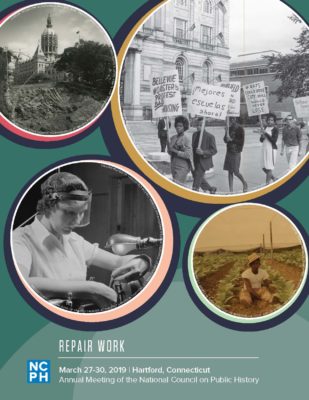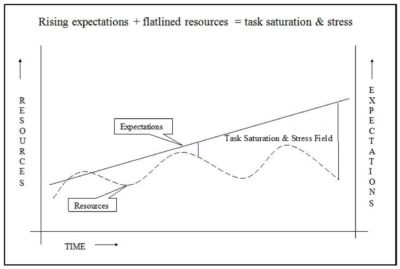Does public history work itself require repair?
20 February 2019 – Paul C. Thistle

2019 Annual Meeting program. Image credit: NCPH
The “Repair Work” theme of the 2019 NCPH Hartford, CT conference immediately makes me think about the need to repair prevailing working conditions in the public history field itself. I strongly believe this work must become part and parcel of the notion among public historians about the need for “repairing a broken world.”[i]
In thinking about your own work in public history, are you possessed by what sociologist Robert A. Stebbins describes as:
a strong and positive attachment to a form of self-enhancing work, where the sense of achievement is high and the core activity (set of tasks) is endowed with such intense appeal that the line between work & leisure is virtually erased?
Moreover, do you find that your work brings you “deep fulfillment,” that you demonstrate “profound love for the job, and a set of deeply felt values”? Do you believe that your public history work is “socially important, highly challenging, intensely absorbing, and immensely appealing” and that you are “rewarded by self-actualisation or self-development” [emphasis added]?[ii]
Stebbins classifies individuals with these characteristics as “occupational devotees” who—significantly—are at risk of addiction to their work.[iii] Stebbins found such job enthusiasts in libraries, archives, and museums. My own experience and research in the museum field has convinced me that a substantial proportion of others with a high level of commitment to “making history relevant and useful in the public sphere” also belong in this classification of occupational devotees. We love what we do, are committed to excellence, and habitually overwork—some of us to the point of addiction.
Sadly, the implications of occupational devotion regarding the Quality of Working Lives (QWL) issues in our field have scarcely ever entered into consideration. To replace a thousand words with a rough picture, my analysis of the problem in the museum and broader public history sector is shown by the following figure (Figure 1).

Figure 1 Conceptual diagram of worker task saturation and resulting stress. Image credit: Paul C. Thistle [iv]
Task saturation is defined as not enough time, tools, and resources to meet expectations.[v]
Over time, resources required to carry out goals and objectives fluctuate, but the expectations of performance among the wide range of stakeholders—from regulators through visitors and employers to us workers—continue to rise without being funded adequately. Sometimes demands on workers rise arithmetically as shown here. In practice, however, expectations in our sector often increase exponentially so that they quickly and greatly exceed available resources—person-power, expertise, time, and money.
Among public history consultants, for example, contract opportunities may arise in bunches, rather than being evenly-spaced with intervening downtime for necessary rest, relaxation, and recovery from unrelenting pressures to perform.[vi]
Occupational devotees regularly—if not chronically—find ourselves functioning in the Task Saturation & Stress Field shown above. We love what we do. We are committed to excellence. When expectations rise above available resources, we habitually work longer, harder, and faster than we are paid to do.[vii]
What does one risk by being an occupational devotee in an environment of constantly rising—yet rarely sufficiently resourced—expectations? I have been arguing for the last 28 years that the danger for occupational devotees in our sector is over-commitment, overwork, and task saturation—i.e. poor QWL. What results for the worker is stress; burnout; and physical, mental, family, and social ill-health.[viii] Some are so negatively affected by the foregoing that they decide to get out of the business altogether. [ix]
In his book Is Work Killing You? that focuses on the wider world of work, medical doctor David Posen, who has been treating stressed workers for more than a quarter century, summarizes the problem that I believe many public history practitioners may recognize in their own working lives:
There is too much work, the pace is too fast, the expectations are too high or unclear, the pressures to perform are too great, and the resources are too few.[x]
Public historians’ occupational devotion and commitment to excellence drives us to intensify our work, regardless of the personal costs. In some cases, management—either by default or deliberate intent—exploits workers to the point of “abuse” according to Posen’s book. The rhetorical question in the title Is Work Killing You? may well be quite possibly yes.[xi]
Formal studies of QWL in our sector are few and far between, but references in the museum literature of the 1980s occasionally referred to problems such as “role overload” and “dysfunctional burnout.”[xii] Personal experience of the author as regional advisor during my first visit to northern Manitoba, Canada, museums in 1990 detected a debilitating problem of mounting stresses in working lives and resulting burnout among both salaried and volunteer workers.[xiii] More formal findings by a university-sponsored study in the following decade reported “a general state of fatigue” and “burnout” among museum workers in Quebec, Canada.[xiv] A 2013 study of museum professionals in Seattle, Washington noted that “over half of respondents agreed . . . life has been too rushed” and they report—while having markedly higher contentment with life than the large general population sample—statistically significant discontent in only one measure of well-being, i.e. “time balance.”[xv] In a UK museum workplace stress survey published in 2015, 65% and 56% of respondents, respectively, stated that funding cuts mean “greater demands have been placed on me” and “I take on more because I care for my organisation.”[xvi] Recently, a 2017 survey of museum workers found that 47% of respondents report “poor work/life balance” as a reason for leaving the field.[xvii]
I apply an aphorism “the straw that broke the camel’s back” to the above widespread QWL problems in our industry. I have personally experienced and observed that workers in the public history field typically are “already fully-loaded camels working in a continual rain of straws.” I take this opportunity now to urge public historians to examine the inevitability of “broken backs” under these circumstances.
I am convinced that we must think seriously about repairing the culture of our own work if we are to be effective in solving the crises in our world as urged on us by the NCPH conference theme and the book by Robert Janes, Museums in a Troubled World.[xviii]
By all means, we must devote our attention at the 2019 NCPH conference and our energies when back at work to “repairing a broken world.” Indeed, the motto of the American Alliance of Museums boasts “museums can change the world.”
However, I maintain that, to succeed in this laudable intention, the practice of public history requires workers who are not burned out to a crisp by a continuous marathon of overwork (as opposed to the temporary emergency sprint needed to open an exhibition on time) that has been institutionalized into “business as usual” for “willing slaves”[xix] in the modern world of work—especially that involving occupational devotees.
Can public historians successfully repair the broken world if we fail to fix our own culture that expects its workers to risk “breaking their backs” as “willing slaves” to our jobs? I think not. However, ways and means of repairing work in the public history field are possible as analyzed in the author’s Solving Task Saturation for Museum Workers blog.[xx]
~ Paul C. Thistle is the former curator & CAO of The Sam Waller Museum (1983-1995) and most recently curator at the Langley Centennial Museum & National Exhibition Centre (2006-2009). He has 26 years of mission and management work in museums. Currently, he is Principal of >Thistle to the Point Museum Consulting.
References
[i] Seth Bruggeman & Cathy Stanton, “Reflecting on Repair: The 2019 Annual Meeting theme,” National Council on Public History History@Work blog posted 6 December 2018 https://ncph.org/history-at-work/reflecting-on-repair-annual-meeting-theme/ (accessed 17 December 2018).
[ii] Robert A. Stebbins, Between Work and Leisure: The Common Ground of Two Separate Worlds (New Brunswick USA: Transaction Publishers, 2004), ix, xii, 10, 17, 76.
[iii] Cf. Ronald J. Burke, “Work Hours and Work Addiction,” in Ronald J. Burke ed., Research Companion to Working Time and Work Addiction (Cheltenham, UK & Northampton, MA: Edward Elgar, 2006), 11, 13, 15.
[iv] Paul C. Thistle, “New Decent Work Developments at ONN,” Solving Task Saturation for Museum Workers (blog posted 1 November 2018) https://solvetasksaturation.wordpress.com/2018/11/01/new-decent-work-developments-at-onn/ (accessed 14 January 2019).
[v] James D. Murphy, “Increase Team Productivity by Decreasing Task Saturation: Too Much to Do and Not Enough Time to Do It” [Podcast & Transcript] Atlanta, GA: Afterburner, Inc., n.d. https://www.afterburner.com/fighting-task-saturation-04/ (accessed 16 February 2019).
[vi] Cf. David Posen, Is Work Killing You? A Doctor’s Prescription for Treating Workplace Stress, (Toronto: House of Anansi Press Inc., 2013), 88-89, 93 passim.
[vii] Cf. Posen, 37-38, 321, passim.
[viii] Paul C. Thistle, “Editor’s Scene,” Little Northern Museum Scene, no. 38 (August 1990): 1 https://solvetasksaturation.files.wordpress.com/2013/09/littlenorthernmuseumeditorial.pdf (accessed 15 December 2018); Nicola Sullivan, “Museum Professionals Have to Meet Higher Demands Due to Cuts,” Museums Journal (Museums Association, UK, 2015); http://www.museumsassociation.org/museums-journal/news/06052015-staff-stress (accessed 11 December 2018); cf. Posen, 2, 45, 87 passim.
[ix] E.g. Claire Milldrum, “Why I Left The Museum Field: A Guest Post By Claire Milldrum,” ExhibiTricks: A Museum/Exhibit/Design Blog (posted 11 September 2017) http://blog.orselli.net/2017/09/why-i-left-museum-field-guest-post-by.html (accessed 15 January 2019).
[x] Posen, 10.
[xi] Posen, 109, 111-112, 247 passim; Madeleine Bunting, Willing Slaves: How the Overwork Culture is Ruling Our Lives, (London: HarperColins Publishers, 2004), xxv.
[xii] David L. Newlands, “Stress and Distress in Museum Work,” Muse Vol. I, No. 2 (Canadian Museums Association, 1983): 20; Gail Dexter Lord & Barry Lord, Yukon Museums Policy and System Plan, (Whitehorse, YT: Government of Yukon, 1986), 116.
[xiii] Thistle, 1990, 1.
[xiv] Philippe Dubé, “View: Towards a New Generic Model for Small and Medium-Sized Museums,” Muse Vol. XIX, No. 1 (Canadian Museums Association, 2001): 8-9.
[xv] Andrea N. Michelbach, “Are Museum Professionals Happy? Exploring Well-Being Across Domains and in the Workplace,” A thesis submitted in partial fulfillment of the requirements for the degree of Master of Arts, (Seattle: University of Washington, 2013): 3, 34-35, 42. Available at https://digital.lib.washington.edu/researchworks/bitstream/handle/1773/23533/Michelbach_washington_0250O_11485.pdf?sequence=1 (accessed 10 December 2018).
[xvi] Sullivan, 2015.
[xvii] Claudia Ocello et al., “Why are Great Museum Workers Leaving the Field? Survey by Claudia Ocello, Dawn Salerno, Sarah Erdman, & Marieke Van Damme,” (2017), 8 https://docs.google.com/presentation/d/1_aHdxmG0Jdb4deqsjyhH9eoDUIPXz_EdkU-7gWuXDwE/edit?usp=sharing (accessed 15 January 2019).
[xviii] Robert R. Janes, Museums in a Troubled World: Renewal, Irrelevance, or Collapse? (New York: Routledge, 2009), 176 passim.
[xix] Cf. Bunting, 2004, xxv, passim.
[xx] Paul C. Thistle, Solving Task Saturation for Museum Workers blog (2012-2019) [first Google hit for “solving task saturation”] https://solvetasksaturation.wordpress.com/ .



